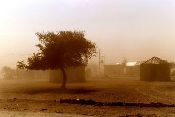|
Using indicators to indentify best management practices |
 |
|
 |
Building on the analysis already shown in »Evaluation and short-listing of indicators, the most important land management practices to protect and prevent desertification from the six main processes affecting the study sites are as follows. |
| Water erosion |
Agricultural areas: Runoff water storage, Sustainable farming, and Land terracing. These land management practices become more effective under low land use intensity and implementation of existing regulations for environmental protection.
Pastures: Grazing control, Soil water conservation, Runoff water storage. Tillage operations become especially important indicators in pastures cultivated for forage production. Of course reduction of the rate of burned area, and land use intensity are crucial indicators for reducing desertification risk in such areas.
Forested areas: soil erosion can be substantially reduced if Fire protection measures are applied, and the land is subjected to low Grazing intensity. Of course desertification risk is greatly reduced if the Rate of burned area is minimized.
|
| Tillage erosion |
Tillage operations, Tillage direction and Mechanization index. Sloping areas under high mechanization index in which soils are tilled by a moldboard perpendicular to the contour lines in the downslope direction are subjected to high desertification risk. Desertification risk is significantly reduced if Land terracing is applied, there is low Land use intensity, and there is adequate Policy implementation of existing regulations on environmental protection. |
| Soil salinization |
Water quality, rate of Ground water exploitation, Soil drainage, and Irrigation percentage of arable land. Areas with good quality of ground water in which exploitation is not higher than recharge rate are subjected to low desertification risk. The expansion of irrigated land using poor quality of water increases the risk of desertification especially in soils with poor drainage conditions. The construction of drainage ditches in poorly drained soils for lowering ground water level or removing excess of irrigation water in areas with arid, semi-arid climatic or dry sub-humid climatic conditions is expected to reduce desertification risk. |
| Water stress |
Rate of Deforested area, rate of Land abandonment, Fire frequency, rate of Ground water exploitation, Soil erosion control and Policy implementation. The highest impact on desertification risk is from the rate of land abandonment and policy implementation. Under high rates of land abandonment, land desertification risk due to water stress is reduced. Of course the implementation of existing policy on environmental protection and especially those regulations related to water resources management alleviates desertification risk. |
| Overgrazing |
Fire frequency, Fire protection, Rate of burned area, Grazing intensity, rate of Land abandonment, and Soil erosion control. Fire protection and rate of land abandonment have the greatest contribution (higher linear coefficient) on combating desertification in overgrazed areas. |
| Forest fires |
Adequate measures on Forest fire protection in forested areas subjected to low or moderate rate of Grazing intensity highly reduce significantly desertification risk. Another important indicator related to land management in forested areas is Land use intensity. If the rate of extraction of wood is sustainable, then the land is adequate protected form desertification. |
Note: indicator names (such as Fire frequency) are are shown in bold. See the report below for full definitions and measurement details.
|





